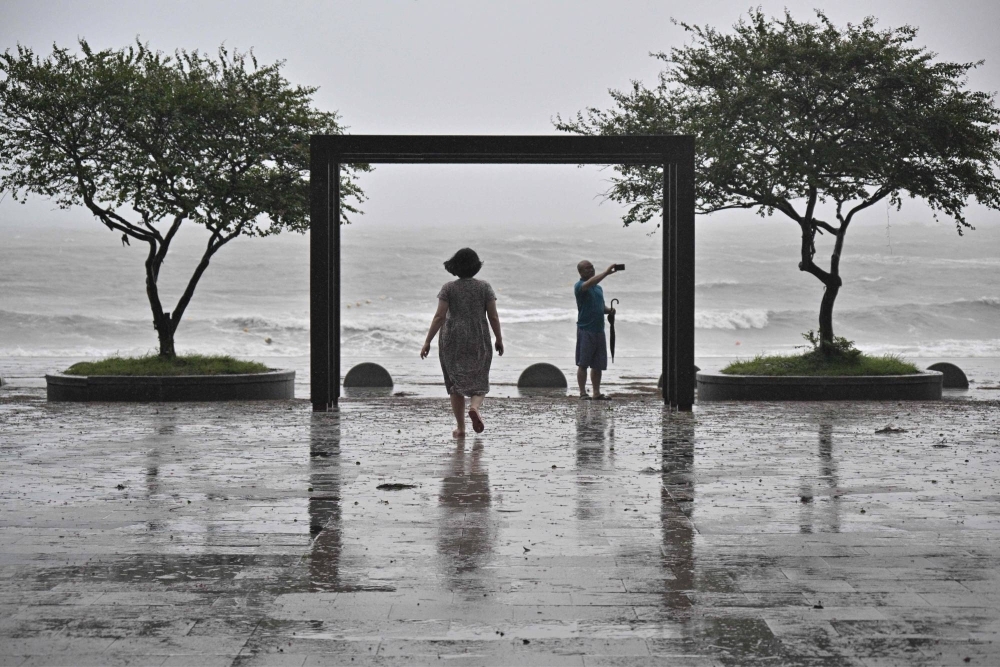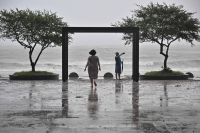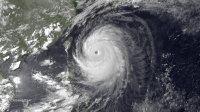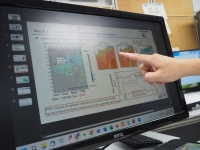The year is 2050, and a typhoon is forecast to make landfall in Japan. But a news report about the coming storm suggests there’s no cause for alarm.
"I'm so happy that a typhoon is coming!” a resident says. “My electricity bills this month will be half the usual price!”
This is the vision — presented in a 2020 paper by Hironori Fudeyasu, the director of the Typhoon Science and Technology Research Center at Yokohama National University — for a world in which humankind has learned to control typhoons.
In the future that Fudeyasu sees, tropical cyclones are a blessing, not a curse: The research he’s leading explores whether the storm systems — known as typhoons, hurricanes or cyclones depending on their location — can be weakened or diverted, with the massive amount of energy they produce tapped to generate power.
That research project is called TyphoonShot, which aims to realize “a society safe from the threat” caused by typhoons “by controlling and modifying the weather by 2050.” It’s part of Moonshot, a government-backed research and development program designed to resolve complex societal issues.
TyphoonShot is clearly ambitious. And perhaps unsurprisingly, it also has its share of skeptics.
Supporters say it’s worth probing what’s possible, but detractors — especially on the issue of controlling the weather — see science fiction, pointing to what they see as numerous practical pitfalls as well as ethical quandaries.
Decades of research
TyphoonShot isn’t the first project to explore the possibility of controlling tropical cyclones.
In 1947, a U.S. program called Project Cirrus used cloud seeding in an attempt to modify a hurricane. The project used dry ice to try and disrupt the cyclone and ultimately weaken it, according to an article on a U.S. National Weather Service website under the headline “Almost Science Fiction.”
But the seeding — while apparently successful — backfired in a major way.
“The hurricane, which had initially been tracking west to east and heading out to sea, reversed its path after it was seeded and made landfall in Savannah, Georgia, causing local destruction,” the Weather Service article says. “Many blamed the seeding for this disaster, which had a negative effect on political and legal arrangements for future modification efforts.”
The fiasco led to the project’s cancellation, and it “set back seeding research for more than a decade.”
Eventually, newly secured funding for hurricane research led to more attempts to probe whether storms could be controlled. From the 1960s through the early 1980s, several U.S. government agencies participated in Project Stormfury, which aimed to find ways to control hurricanes, again through cloud seeding.
Researchers sought to weaken cyclones by flying aircraft into the storms and seeding them with silver iodine, which they theorized would cause a hurricane’s supercooled water to freeze, disrupting the structure of the storm.
“To make up for this disruption, the hypothesis formulated, the wall of the storm’s eye would have to reform, thereby decreasing the maximum wind speeds by up to 30%,” the Weather Service article says. “Since the amount of damage a hurricane can do relies heavily on the speed of its winds, even the smallest reduction could potentially make a huge difference in protecting lives and property.”
Due to the strict criteria of the project, only a small number of storms were actually seeded, and while some were deemed successful experiments, the results were considered inconclusive. Then, further roadblocks emerged. Researchers realized they would need several hundred tests to prove their hypothesis, yet they found it difficult to find cyclones acceptable for such experiments.
In the 1970s, the project began to shift away from attempts to alter hurricanes, focusing instead on understanding them. Part of that research revealed two key facts that raised new questions about the feasibility of controlling tropical cyclones — namely, that hurricanes didn’t produce as much supercooled water as expected, making seeding less effective, and that the results of seeding were essentially indistinguishable from naturally occurring changes in hurricane intensity.
Project Stormfury was officially shelved in 1983.
In the following decades, additional research related to the modification of tropical cyclones has continued. But some of the scientists involved now maintain that any such efforts are a waste of time.
Controlling a storm
Fudeyasu leads the way as we climb up a short, steep stairway to a fenced-in rooftop space atop a building on the Yokohama National University campus, where he shows off a series of weather instruments and cameras used to monitor conditions and gather data, including about any passing tropical cyclones.
He coaxes a cadre of his students to pose for photos in front of the instruments, with central Yokohama’s skyline and Tokyo Bay visible in the background.
It’s not hard to imagine a typhoon rolling ashore from Tokyo Bay, packing damaging winds and torrential rains. While mainland Japan is usually spared the worst — storms generally weaken as they tread north — stronger storms occasionally make landfall. And because warmer water helps make storms more powerful, climate change is making things worse.
“My research ... shows the increase of typhoon intensity due to global warming,” Fudeyasu says, citing a 5% to 10% increase attributable to climate change.
With TyphoonShot, he wants to reduce the intensity of storms by roughly the same amount, which he says could save lives and reduce damage. The goal, he wrote in the 2020 paper, is to minimize the threat caused by typhoons — not to stamp them out completely.
One of the issues with Project Stormfury in the U.S. was a lack of clarity about what effect the cloud seeding actually had. Fudeyasu maintains that this problem can be solved with highly accurate monitoring — including by flying aircraft through storms to collect data — analyzed against a range of parameters generated through advanced computer simulations.
But exactly how a storm can be controlled remains elusive. TyphoonShot researchers are probing numerous potential methods, including variations of cloud seeding but also newer ideas like pumping cold water from deeper in the ocean to the surface, which researchers theorize could help reduce a storm’s intensity.
The other key element of TyphoonShot is converting the power of tropical cyclones into usable energy. One proposed method for this, described in Fudeyasu’s 2020 paper, involves sailing unmanned vessels into the weaker portion of a moving typhoon, with screw propellers submerged undersea generating power.
While it may seem far-fetched to imagine a vessel surviving — let alone functioning — inside a typhoon, the researchers say ships can be designed to withstand the intensity. Fudeyasu’s paper casts this technology as being in an initial research stage, but he describes it as having “sufficient potential feasibility.”
He also sees the potential for this to play a role in the green energy transition.
“Typhoon power generation can expand the available methods of renewable energy generation, which has great potential for supporting Japan's long-term green growth strategy,” he writes in the 2020 report. “It is entirely possible for Japan, which has been called 'energy-poor,' to become a renewable energy superpower in a carbon-free society by turning the threat of typhoons into a blessing.”
‘Difficult if not impossible’
Moshe Alamaro, an atmospheric scientist who worked at the Massachusetts Institute of Technology for 23 years, was involved in past studies related to hurricane modification, but he’s come to the conclusion that it’s not worth the effort.
“The fundamental problem of weather modification is that controlled experiments are difficult if not impossible,” Alamaro says. “There is always uncertainty that the outcome of the modification, such as enhancing rainfall, is due to the modification or the natural variability of weather.”
Further, he warns of “daunting” legal and geopolitical ramifications. In one scenario, he imagines that a storm is not actually modified at all, but an injured person is under the impression that it was and chooses to file a lawsuit
But it’s not just lawsuits he’s concerned about.
“What if a hurricane is diverted unintentionally to North Korea?” he asks, warning of the risk of international conflict.
Robert Speta, a meteorologist and typhoon expert who was previously based in Japan, also sees major challenges to any efforts to alter storms.
“If a storm is seeded and then it undergoes a structural change that causes it to change direction, and that same storm hits land and causes damage, how do you confirm the change in direction was natural or man-made, or even more so who is on the hook for the damage? Is it an act of God or is someone to blame?” Septa says. “Take this a step further. Let’s say Japan seeds a storm in the Pacific and it hits China, is China in the right to say all the damage from the storm is Japan’s fault? How do you confirm that?”
Septa, who operates a YouTube channel on typhoons called WestPacWx, also sees potential problems with how controlling storms could impact natural weather patterns.
“Of course if you had a magic button that made a storm go poof that would be great in the short term. But the ultimate goal of a hurricane is to transport warm air from the equator north,” he says. “What long-term impacts would that have to change that pattern?”
But Speta does agree with Fudeyasu that improving technology could change the outlook.
“I think that technology has improved dramatically over the past few decades that would help with this research,” he says. “I think if they have the theory and enough computing power, and a proper way to deploy said theory, their chances are much better than previous projects.”
To that end, Fudeyasu is aiming for what may seem a high bar: perfection.
“If we cannot do a perfect simulation,” he says, “we cannot do modification.”












